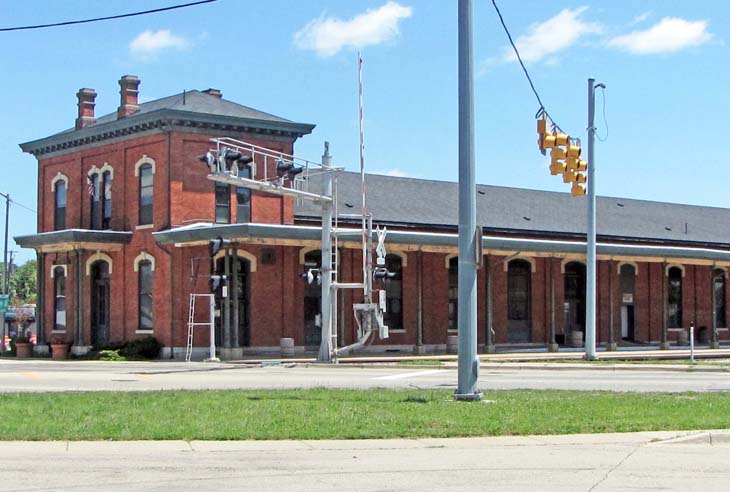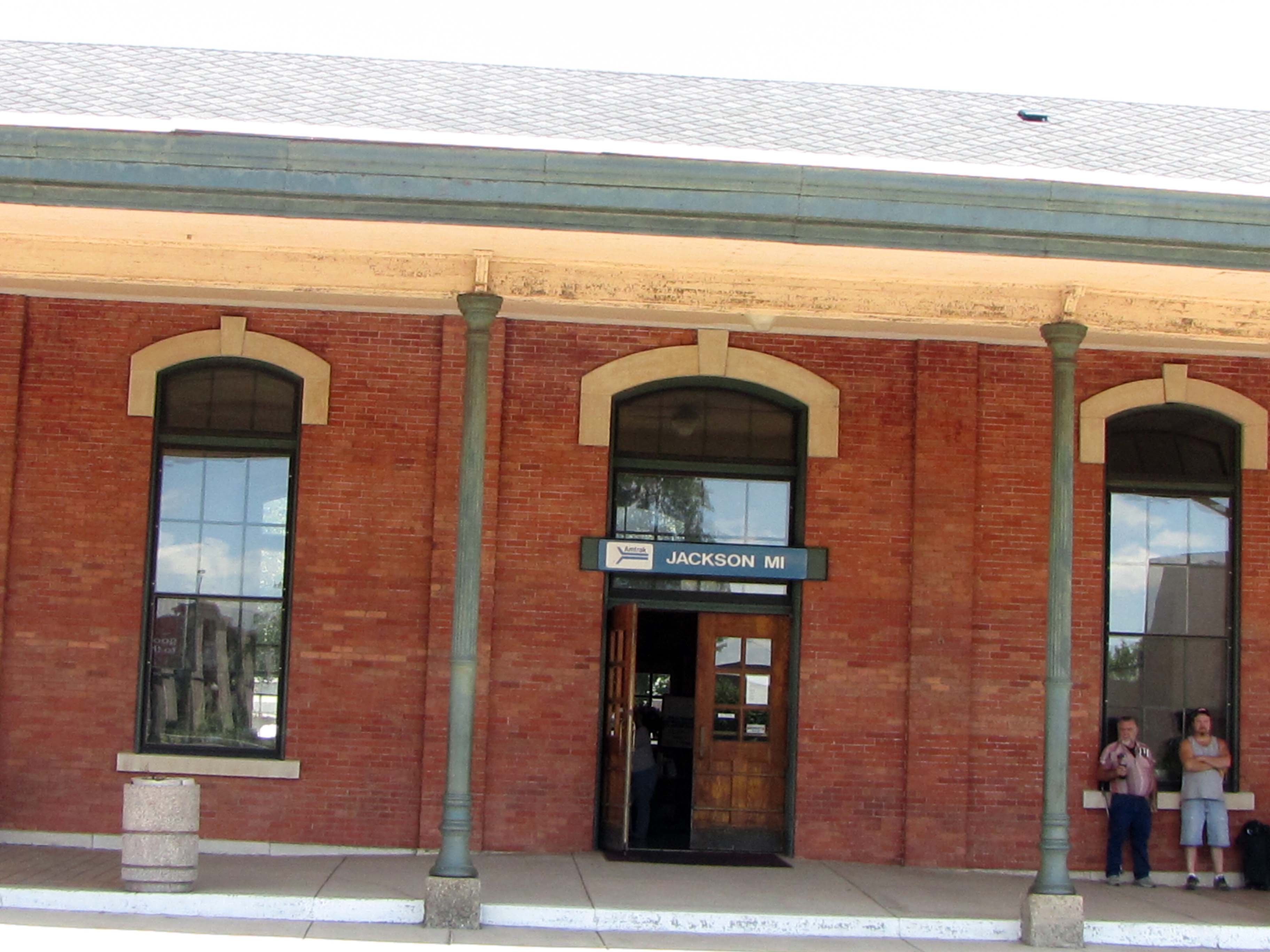

No passenger station in the United States has been in continuous use longer than the very attractive but unusual Italianate depot you see pictured above. Michigan’s first governor, Steven T. Mason, promoted three railroads that would link waterways on the east side of the state to those on the west side. He hoped to attract migrants to Michigan and derive tax revenue from the goods that would be shipped across the state on their way to or from the American Midwest. A southern rail line would be just north of the state line and would extend from Monroe on Lake Erie to New Buffalo on Lake Michigan where goods and passengers would transfer to a ship for the short trip to Chicago. A central line would go from Detroit to St. Joseph. He was less specific about the northern line but presumed that it would reach from a point on the St. Clair River near Port Huron to the mouth of the Grand River. Private investments were unable to finance much construction so the state issued bonds and eventually ended up with ownership of the southern and middle lines. By December, 1841, the central line – known as the Michigan Central – reached Jackson from Detroit. Lacking capital, the line built west slowly reaching nearby Albion in 1844. It was extended west toward the Lake Michigan shore but as it reached the state’s western coast it became clear that an all-rail route to Chicago was preferably to the rail then water route that first Governor Mason foresaw.

By the late 1840s, the state was losing much on its investment in rail lines so the legislature decided to sell them. Various conditions were specified. One condition for sale of the incomplete southern route was that a branch line be built north from Tecumseh to Jackson to connect to the central line. The new owner—with the rail line then called the Lake Shore and Michigan Southern— complied and by 1857, Jackson had rail service in three directions. Perhaps that was enough to make Jackson into something of a hub and, eventually, spokes extended from the city in nine directions.
By 1865, a line was completed north to Lansing. Three years later a different line reached Grand Rapids. In 1869, a new road connected Jackson to Fort Wayne, Indiana and the next year, a short cut rail line was completed from Jackson to Niles, a route that passed by the traffic centers of Battle Creek and Kalamazoo. This was known as the Michigan Air Line. In 1883, a new line extended from Jackson to Pontiac and then the final line was completed in 1886 and linked Jackson to Cincinnati. The Michigan Central and New York Central eventually owned all of these lines except the one to Pontiac that was owned by the Grand Trunk Western. By 2010, only four lines remained active; the major east west line, the line to Lansing and the line south toward Fort Wayne.
Just after the Civil War ended, Cornelius Vanderbilt realized that there was a fortune to be earned by controlling the transportation market from Chicago to New York. When he began building his empire, many railroads were within-state entities that served a specific hub. Few lines crossed state lines or went long distances. Indeed, different gauges and challenges spanning major rivers or swamps impeded the development of a national rail system. Vanderbilt began assembling rail lines that would efficiently link New York and Chicago, including his own New York Central across New York State, the Canada Southern Railroad across southern Ontario and the Michigan Central that carried traffic from the Detroit River to Chicago. Freight and passenger business boomed in the years following the Civil War as modern manufacturing emerged and the nation’s population grew rapidly. By the early 1870s, Vanderbilt’s Michigan Central was a prosperous entity and a key component of his eastern railroad empire.
This depot that you see was the first of the very large and architectural significant stations that the Michigan Central built in its major cities. It officially opened on September 1, 1873, although I read that trains were using the depot at earlier dates. The final such monument to this railroad’s financial capability was the 1912 Michigan Central Station at Roosevelt Park in Detroit. At the time this Jackson depot was designed, there was little consensus about what a station should look like or what message it might convey. Eventually, stations came to emphasize the importance of the city where they were located but a variety of different than contemporary styles were used by architects. I do not know why Italianate was chosen for Jackson. It is quite unusual. Indeed, I cannot think of another Italianate station in this country.
This station is in remarkably good condition. You can see the imposing two-story head house component facing downtown Jackson to the west. To the east of that component is the area containing a large wood paneled waiting room with a ticket window that probably resembles the original structure that architect Gardner installed. Further east is a separate area, presumably designed for package freight. The brick work is elegant. Particularly impressive is the curved walnut arch that separates the ticket office from the waiting rooms. That is correct. Mores have changed over the decades. This depot, along with the Michigan Central depot in Niles, was designed with separate waiting rooms for men and for women. I wonder if the frequent use of chewing tobacco by men encourage architects to separate the sexes. You will notice that the builder selected expensive slate for the roof. This was done to protect his building from fire. Steam engines often emitted sparks that landed on nearby surfaces and many railroad structure burned. In the era of the early steam engines, few, if any railroad stations, were built with flammable roofs. The problem was minimized later when effective spark prevented were installed on the stacks of steam locomotives.
In 2008, the state of Michigan appropriated $300,000 to maintain and upgrade this facility, and the next year, $938,000 in federal stimulus funds became available for the same purpose. This should ensure the future of this structure, at least until its second century birthday. It may be used as transportation similar to the Amtrak depots in Battle Creek and Kalamazoo. In 2010, this station was served by three west bound trains to Chicago and three east bound trains to Detroit and Pontiac. In fiscal year 2010, 28,506 passengers boarded Amtrak trains at this depot. It is a pleasure to slowly walk around this depot and appreciate the crafts of its designer and builder.
Builder: Henry A. Gardner
Date of Construction: 1872
Architectural Style: Italianate
Use in 2010: Amtrak passenger station
Website: http://www.greatamericanstations.com/Stations/JXN/Station_view
Friends of Jackson station website: http://friendsofjacksonmcstation.webs.com/
State of Michigan Registry of Historic Sites: P47617
State of Michigan Historical Marker: None erected
National Register of Historic Places: Listed December 12, 2002
Photograph: Ren Farley; June 30, 2010
Description updated: May, 2011
Return to Transportation
Return to Home Page